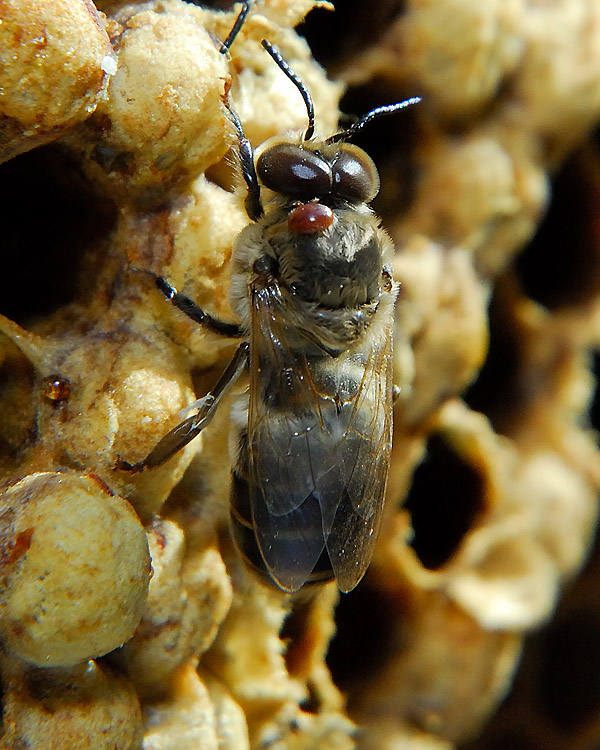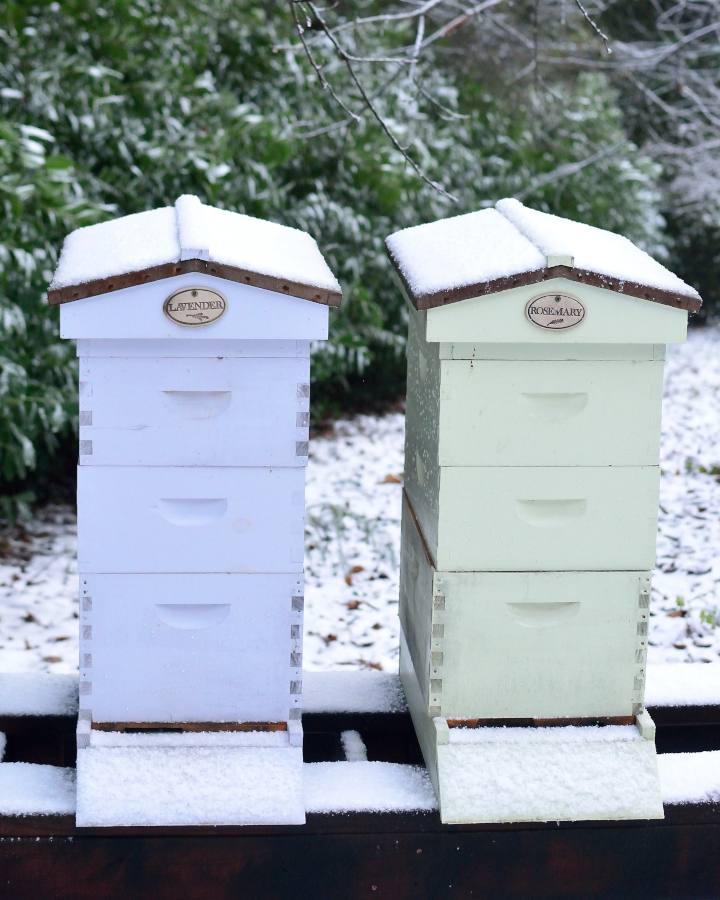The Apiary
The apiary is primarily for pollination of the gardens and orchard, but also provides honey and wax for our handmade goat milk soaps. The colonies are managed organically. We emphasize requeening with hygienic stock, including Saskatraz. By employing drone brood trapping, seasonal colony divisions, and selecting for strong over-wintering colonies, varroa burdens can be kept relatively low, along with the diseases vectored by the mites.
As the orchard and gardens continue to grow we observed a host of native pollinators in the garden, from bumble bees, to sweat bees, butterflies, and beetles. However, there was a relative lack of honey bee pollinators visiting the edible garden and orchard. In the spring of 2011 we decided to venture into beekeeping.
Our first hive was populated with a large feral swarm we captured from a neighboring property.


We subsequently captured a small afterswarm from the same parent colony two weeks later. Later that spring we received two packages of bees that we had pre-ordered in January. The Curbstone Valley apiary expanded to four bee colonies, the Salvia, Rosemary, Chamomile, and Lavender hives. That season we had an opportunity to compare the health and vigor of local feral bees versus packaged Italian colonies.
We shared our experiences on the blog as first year beekeepers, both the highs, and lows, as beekeeping, in the presence of Varroa mites, is more complex than it’s been in times past.
The first winter we lost both package Italian bee colonies. The first collapsed in late fall due to a combination of Varroa load and robbing yellow jackets. The second hive met its demise when the hive population suddenly crashed in early January, and then the Queen flew off during a brief hive inspection to see what was going on.
Both feral colonies, however, appeared to come through winter with flying colors, and in late February the following year we split the first of these colonies, Salvia, in the hopes of encouraging the rearing of a new, robust Queen. At the end of March, we also split the remaining feral colony, Lavender, bringing our total number of hives in the apiary back to four. By splitting these colonies, we hoped to reduce Varroa load that season, and encourage the production of strong, healthy, local Queens that are better adapted to this area than the commercially sourced bees. Over time we hope that by splitting our survivor hives each spring that we’ll gradually be selecting for more Varroa-resistant colonies.
Despite the challenges associated with modern day beekeeping, we’re finding it to be a very rewarding, and exciting hobby. The bees never fail to teach us something new, and the honey they produce is divine.


We don’t use pesticides on the farm, or in our hives, instead using a combination of drone trapping, screened-bottom boards, and genetic selection by splitting our most robust over-wintered hives, to encourage colony strength and health. An important element for health and survival is also not to overharvest honey stores, especially heading into winter. We recently started to re-queen our colonies with Saskatraz queens, due to the increased grooming behavior exhibited by these bees, and their willingness to forage at cooler temperatures during the fall-spring months. We are always working on bringing in more bee-friendly plants, both native, and well behaved non-native forage plants to help support our bees on the farm, and as such, Curbstone Valley Farm is certified as a ‘Bee Friendly Farm‘.

Our gardens, particularly the kitchen garden, would not be as productive without maintaining the apiary here. While we are not striving to be in the commercial honey business, we do judiciously occasionally harvest excess honey for use on the farm, and to occasionally share a jar or two with friends.
“The hum of bees. is the voice of the garden” – Elizabeth Lawrence
